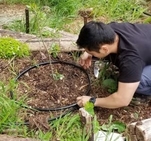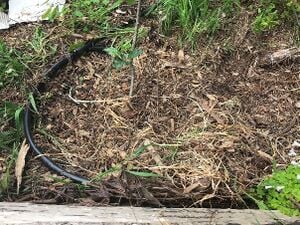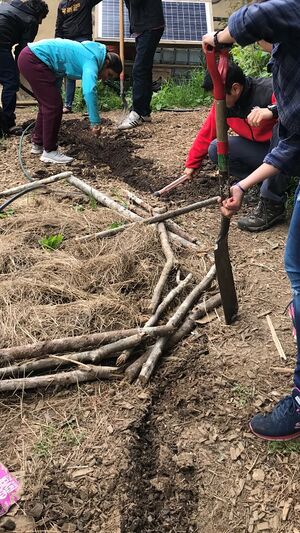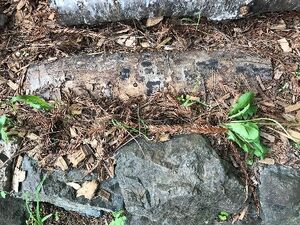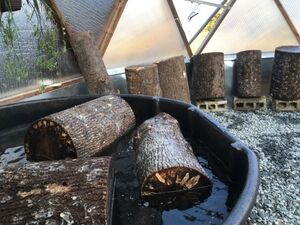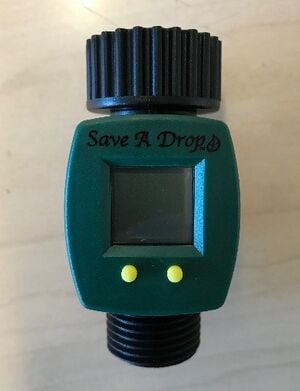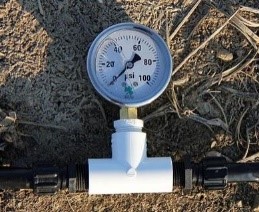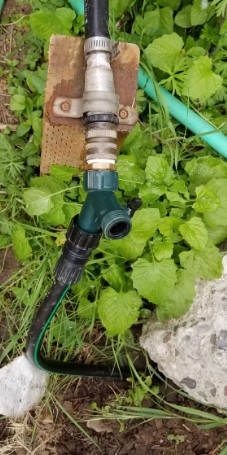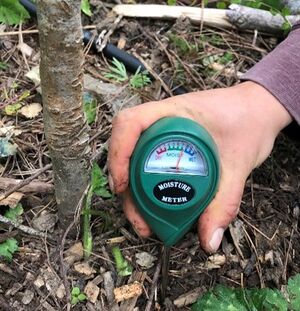
This is the Operation and Maintenance (O&M) manual for CCAT rain water catchment drip irrigation system. Please refer to it and keep it up to date with any O&M changes.
Operation[edit | edit source]
The main components of the system are the storage tanks, valves, main line tubing, drip emitter tubing, and the fittings to connect the tubing.
Additional components to the system are the soil moisture sensors and mulch.
The following guidelines should be followed for optimal use of stored rainwater:
- Open valves to initiate water flow
- Ensure that watering events are timed appropriately (approximately 8 minutes per week)
- Schedule irrigation activities to occur early in the day to minimize water loss by evapotranspiration
- Monitor moisture, read outputs from moisture meters in food forest soil to confirm need for watering
Maintenance[edit | edit source]
To keep the system functioning efficiently, it is important to check the condition of the drip irrigation lines carefully. To conduct a thorough check for damage, the drip irrigation lines should be removed, visually inspected, and re-installed once every year. During this inspection, it is also important to ensure that emitters are free of debris and free of physical wear that could result in leaks. Finally, the position of the drip line should be maintained with anchoring pins. It should be kept out of walkways and other potential areas of foot traffic at CCAT. Any sharp bends or kinks in the drip line should be straightened out and pinned into place. To protect the line from the elements, it should be kept underneath mulch and/or soil.
Mulch should be reapplied at least once every year. Decomposition of the organic matter will yield less effective moisture retention. The depth of the mulch layer should range from 3 to 4 inches.
Soil moisture meters should be cleaned and stored when not in use. The meters' locations in the food forest or elsewhere on CCAT grounds should be recorded to prevent equipment loss or damage.
For consistent water use plans, we recommend keeping a log of the amount of water used during each watering activity as well as the remaining tank capacity levels. This will help to inform the next watering event and allow for decisions to be made about the system for the next generation at CCAT.
Schedule[edit | edit source]
Daily
- Check moisture meters to see if trees need water
- If soil is dry, open valves to drip irrigation and water for 8 minutes
Weekly
- Water for 8 minutes with drip irrigation
- Check valves and tubing for leaks or other damage
Monthly
- Check condition of drip line and mulch
- Make repairs and adjustments as needed
Yearly
- Remove drip line during winter months and inspect for damage
- Reinstall drip line in the spring and reapply mulch
Every 5 years
- Inspect drip line and main line, and replace if needed
Instructions[edit | edit source]
The water flow meter fits ¾ standard outdoor hoses and faucets. To properly install the meter, clean pipe ends and tighten as necessary. The meter will help monitor water usage, knowing the flow rate helps with scheduling and maintenance. The system flow rate will vary based on irrigation design and number of emitters.
The pressure gauge can be installed using a ½ inch tee fitting connecting different parts of the main or drip line. Most pressure gauges for irrigation systems are not designed for constant pressure and must be removed after use. Monitoring pressure helps identify when maintenance may be needed. Changes in pressure can be indicators of clogging or leak issues.
The moisture meter can be used by inserting the metal probe deeply into the soil surrounding the trees of interest. The indicator dial shows the moisture levels. The moisture of the soil should be checked before watering to confirm the need for water, but can also be checked periodically to make sure that the plant is not over- or underwatered. The meter works to identify soil moisture through electric conductivity, so it is important that the meter is removed, cleaned, and safely stored after every use.
A high flush rate is needed to clean and remove the buildup in the irrigation lines. The city water outlet can be used to flush the irrigation lines. This can be achieved by connecting the main line (shown in figure) directly to a city outlet spigot. If the main line of the drip system is already fixed, an extension hose and male to male fittings can be used to provide the required pressure for flushing.
Troubleshooting[edit | edit source]
| Problem | Suggestion |
|---|---|
| Emitter not delivering water | Emitter might be clogged due to small solids in the drip line. Check emitter and clean it with a needle to remove dirt or other precipitates. |
| Leakage in drip or main line | Main lines and drip lines can be damaged by mechanical means, wild life, and/or environment conditions. Damaged parts can be replaced by cutting the damaged portion and reconnect using a joiner/connector fitting. |
| Leakage in fittings | Fittings can be damaged by mechanical means, wild life, environment conditions as well as pipe expansion and frequent use. If the pipe expanded, that portion of the pipe can be cut, and the same fitting can be reused. If the fitting is too loose for the pipe diameter it can be adjusted by heating it. |
Suggestions for future changes[edit | edit source]
Prioritize trees which are most susceptible to water stress. Juvenile trees should be high on the list. Large, mature shade trees and shrubs can be left alone unless the drought is severe and the trees begin to wilt, or the root systems have been recently disturbed.
Schedule irrigation periods to align with times of the day when temperatures are cooler and there is less wind, such as early morning hours.
Analyze the type of soil in the food forest landscape, because soil type largely determines how often it should be watered. Clay soils hold more water than sandier ones and can can go longer between watering events.
Monitoring soil moisture is recommended. Sensors should be placed in the active root zone where water is applied, and must be near trees representative of the irrigated area.
Apply mulch to inhibit weed growth, conserve soil moisture and moderate soil temperatures. Mulch minimizes water evaporation from the soil surface. Keep mulch 3 to 4 inches away from the trunk or stem of the plant to prevent moisture accumulation and eventual rotting. Keep zone around tree trunk weed free to decrease tree competition for water and nutrients.
